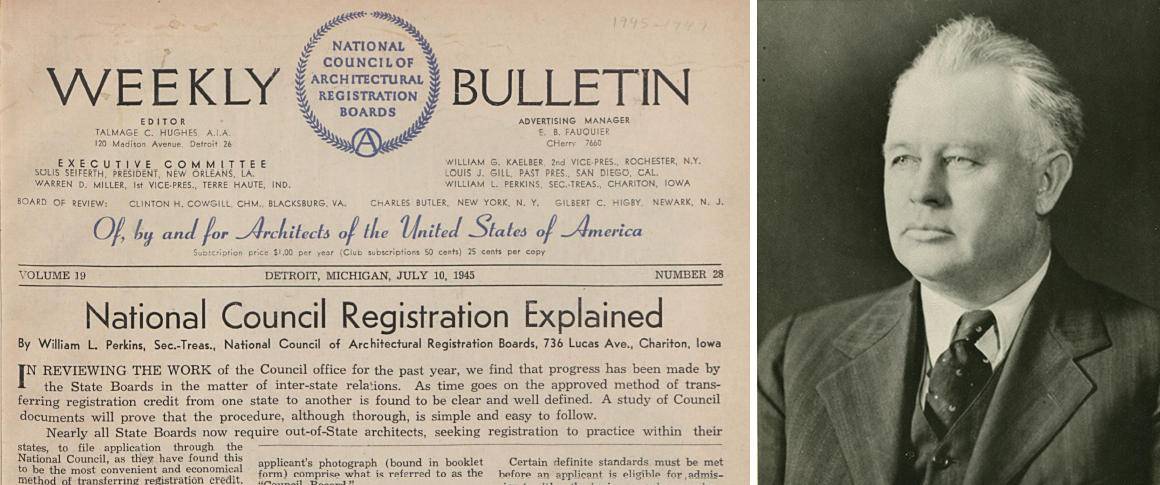NCARB is celebrating its centennial this year! As a part of the celebration, we will be posting articles from our archives to remember the history and evolution of the organization. A version of this article, written by NCARB Executive William L. Perkins, originally appeared in a 1945 edition of the NCARB Weekly Bulletin.
In reviewing the work of the Council office for the past year, we find that progress has been made by the state boards in the matter of interstate relations. As time goes on, the approved method of transferring registration credit from one state to another is found to be clear and well defined. A study of Council documents will prove that the procedure, although thorough, is simple and easy to follow.
Nearly all state boards now require out-of-state architects, seeking registration to practice within their states, to file application through the National Council [of Architectural Registration Boards], as they have found this to be the most convenient and economical method of transferring registration credit. Application through the National Council is made by means of a Council Record.
The applicant, upon request to the Council office for necessary information and instructions, is furnished with the proper blanks to make application for a Council Record, as well as a copy of Circular of Advice No. 4 “Interstate Practice,” which explains in detail the preparation of a Council Record.
Two forms of blanks are used in making application for Council Records: One for senior applicants, or architects who have been engaged in practice as principals for 10 or more years, and the other for junior applicants, or those who have been in practice a shorter time.
After the proper blank is filled in by the applicant, it is forwarded to the Council office, together with the $25 fee to defray expense of preparing and transmitting a certified copy of the Record to the registration board in the state in which application for registration is being made.
As soon as the application form is received by the Council office, inquiries are mailed to all references given on the application, and the Council Record is assembled as rapidly as possible. It usually takes about three or four weeks to complete a Council Record, which is made up of statements received from the applicant’s references. This thorough and disinterested investigation, together with the applicant’s photograph (bound in booklet form) comprise what is referred to as the “Council Record.”
Upon completion of the Council Record, a certified copy is forwarded to the state board in the state where the applicant is applying for registration. This furnishes the state board with a certified transcript, in booklet form, of all replies to inquiries which have been addressed by the National Council to the applicant’s reference. The state board then has unbiased, authentic evidence concerning an architect’s training, practice, and professional standing. Such evidence is generally considered sufficient to determine whether or not an applicant is eligible for registration in that state.
Some states accept the Council Record as a complete application, while others require the filing of a state application form, in addition to the Record. The applicant is notified by the Council office as to whether or not a state form is required. A state fee is also to be paid.
Establishing a National Exam for Architects
In order to establish a basis of architectural qualifications which can be accepted without question by all states as equal to their own requirements, the National Council of Architectural Registration Boards has devised voluntary examinations known as the Standard NCARB Examinations, which are as near to the national examinations as is possible in the United States.
The passing of the Standard NCARB Examinations gives an architect a high professional rating and carries the recommendation of the Council that they be granted registration in any state without further examination.
The first step in the examination procedure, in either the junior or senior classification, is the preparation of a Council Record, as outlined above. However, not every architect who has a Council Record is eligible to take the Standard NCARB Examinations.
Certain definite standards must be met before an applicant is eligible for admission to either the junior or senior examinations, as explained in detail in Council Circular of Advice No. 3 “The Standard NCARB Examinations.” Not until the Council Record is completely assembled can an applicant’s eligibility to be admitted to the examinations be determined.
As soon as an applicant’s eligibility is established, they are requested to pay the Council fee of $15 for investigation and verification, and a copy of their Council Record is mailed to the state examining board, in the state in which they are to take their examinations, with a formal request to the examining board to conduct the Standard NCARB Examinations according to the rules and regulations of the state board, plus such supplemental examinations as may be necessary to meet the requirements for the standard NCARB examinations.
No NCARB examinations may be given by a state examining board until the candidate’s Council Record, formally approved by the Council, has been received, together with the request from the Council office to conduct the examinations.
After the NCARB examinations have been completed, the state examining board must file with the Council office a report on the results of the examinations. This report should be written up according to a standard form set up by the Council, as it will be included as a part of the applicant’s Council Record whenever transfer is made to other states.
All architects who can meet the requirements should take advantage of such an opportunity to qualify for a registration rating on the highest standard obtainable. When an architect holds a Council Certificate, many delays and misunderstandings in reciprocal registration are avoided.
Join us in celebrating our accomplishments and important milestones over the past 100 years by navigating through archived photos, videos, state histories, and more.
